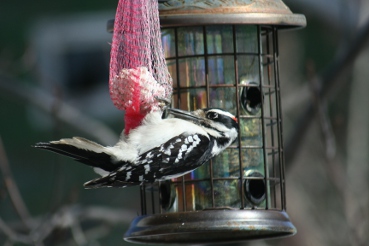Having kept the thermostat down last night, there is a real reluctance to get out of bed, but this one must do. I grab a gown and walk down the stairs as the morning light is passing through the kitchen window. No fresh snow today but the white ground is covered well. Hanging from the red maple tree is the suet feeder, and though it is early, there is something meticulously working the contents.
A grid pattern of black and white with a bright red sash near the head identifies the early visitor. It is positioned on the feeder in a tri-stance with two legs holding firm and a tail tip acting like a third limb to give it balance. Head bobbing back and forth, it penetrates or rather, finds the perforated holes and worries the white glob of suet, so prized for its hidden energy source. A downy woodpecker has beaten me to the morning activities.
There are two common species of woodpeckers in the Sudbury and surrounding areas that can be counted on to visit our backyard feeders in winter. Both have black and white speckles and strips on their plumage and could be misidentified on cursory looks.
The smaller downy woodpecker has white outer tail feathers with small black strips breaking up the white backdrop. The male has a red sash on the head which is not present on the female.
The larger hairy woodpecker has a louder call and has all-white outer tail feathers.
Both species use nesting cavities to rear their young in early spring. In winter, cavities that were used as nests in the past become night residences. This protects the birds from the elements, severe temperatures and conceals. Sometimes they will share the hole for added body heat.
With a little careful observation, one can watch the birds take an indirect route to the hole, then move to the home tree and pop into the cavity just before sun sets. This evasive action helps the bird survive the nighttime activities of attentive mammalian predators.
Woodpeckers have a unique adaptation that allow them to extract insect larvae from holes in trees. They have a long prehensile tongue looped around the back of the skull just under the skin. This allows an extension of the tongue to enter into a hole in the bark. The sides of the tongue have small rigid barbs which act like hooks and help to force the grub out of its domain and become dinner.
The three-point stance of the woodpeckers allows them to stabilize their positions when feeding in this manner. When they move up the tree to find or make new holes, they flick themselves upwards with the tail and the legs working in unison. On to the next meal.
There is another unique feature of the hairy and downy woodpeckers. Their skulls have an air pocket between the bony layers which helps to absorb the shock when they are banging their beaks into the wood to extract food.










